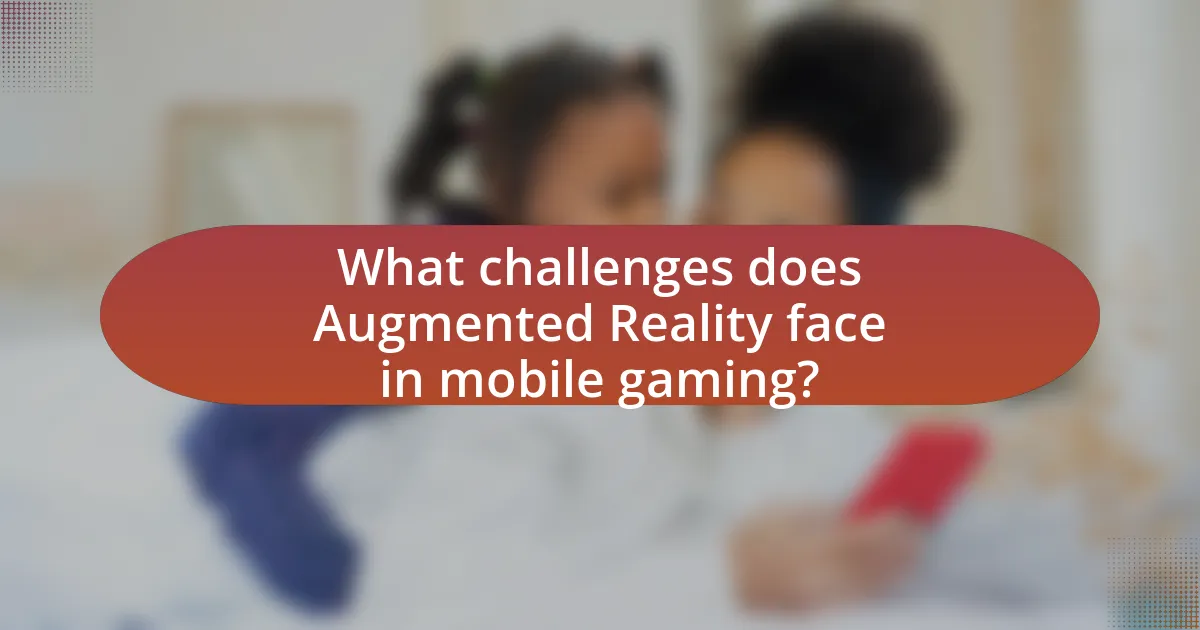Augmented Reality (AR) is significantly transforming mobile gaming by creating immersive experiences that integrate digital content with the real world. This article explores the key features of AR in mobile gaming, including real-world integration, interactive gameplay, and enhanced user experiences, as exemplified by successful games like Pokémon GO. It also examines the technologies enabling AR, the factors driving its popularity, and the challenges faced in terms of technical limitations and user privacy. Furthermore, the article discusses the future of AR in gaming, highlighting advancements in technology, potential impacts on game design, and emerging business models that could reshape the industry.

How is Augmented Reality Transforming Mobile Gaming?
Augmented Reality (AR) is transforming mobile gaming by creating immersive experiences that blend digital content with the real world. This technology enhances gameplay by allowing players to interact with virtual elements in their physical environment, as seen in popular games like Pokémon GO, which generated over $1 billion in revenue within its first year by encouraging outdoor exploration and social interaction. AR’s ability to provide real-time feedback and context-aware gameplay is reshaping user engagement, making gaming more interactive and accessible. Additionally, AR technology is being integrated into various genres, from puzzle games to educational applications, further expanding its impact on the mobile gaming landscape.
What are the key features of Augmented Reality in mobile gaming?
The key features of Augmented Reality (AR) in mobile gaming include real-world integration, interactive gameplay, and enhanced user experience. Real-world integration allows games to overlay digital content onto the physical environment, enabling players to interact with virtual elements as if they were part of their surroundings. Interactive gameplay is characterized by the ability to manipulate and engage with these digital objects, often using gestures or movements, which creates a more immersive experience. Enhanced user experience is achieved through the use of AR technology, which can provide contextual information and dynamic content that adapts to the player’s environment, making the gaming experience more engaging and personalized. These features are evident in popular AR games like Pokémon GO, which utilizes GPS and camera functionality to blend the virtual and real worlds seamlessly.
How does Augmented Reality enhance user experience in games?
Augmented Reality enhances user experience in games by integrating digital elements into the real world, creating immersive and interactive gameplay. This technology allows players to engage with virtual characters and objects as if they exist in their physical environment, increasing engagement and emotional connection. For instance, games like Pokémon GO utilize AR to encourage players to explore their surroundings, leading to increased physical activity and social interaction. Research indicates that AR can improve user satisfaction and retention rates, as players are more likely to continue playing games that offer a unique and engaging experience.
What technologies enable Augmented Reality in mobile gaming?
Technologies that enable Augmented Reality in mobile gaming include computer vision, simultaneous localization and mapping (SLAM), depth tracking, and sensor fusion. Computer vision allows devices to interpret and understand the visual environment, enabling the overlay of digital content onto the real world. SLAM technology helps in mapping the environment while tracking the device’s location within it, which is crucial for placing virtual objects accurately. Depth tracking enhances the realism of AR experiences by measuring the distance between the device and objects in the environment. Sensor fusion combines data from various sensors, such as accelerometers and gyroscopes, to improve the accuracy and responsiveness of AR applications. These technologies collectively enhance user interaction and immersion in mobile gaming experiences.
Why is Augmented Reality gaining popularity in mobile gaming?
Augmented Reality (AR) is gaining popularity in mobile gaming due to its ability to create immersive experiences that blend digital content with the real world. This technology enhances user engagement by allowing players to interact with their environment in novel ways, as seen in successful games like Pokémon GO, which generated over $1 billion in revenue within its first year. The integration of AR in mobile gaming also leverages the widespread availability of smartphones equipped with advanced cameras and sensors, making it accessible to a broad audience. Furthermore, studies indicate that AR can increase the time spent on games, with players reporting higher satisfaction levels when engaging with AR features.
What trends are driving the adoption of Augmented Reality in gaming?
The adoption of Augmented Reality (AR) in gaming is primarily driven by advancements in mobile technology, increased accessibility of AR development tools, and the growing demand for immersive gaming experiences. Mobile technology improvements, such as enhanced processing power and camera capabilities, enable more sophisticated AR applications. Additionally, platforms like Unity and ARKit have made AR development more accessible to developers, fostering innovation. The demand for immersive experiences is evidenced by the success of games like Pokémon GO, which generated over $1 billion in revenue within its first ten months, highlighting the commercial viability of AR in gaming.
How do user demographics influence the growth of Augmented Reality games?
User demographics significantly influence the growth of Augmented Reality (AR) games by determining the target audience’s preferences, engagement levels, and spending habits. For instance, younger demographics, particularly those aged 18-34, are more likely to adopt AR technology due to their familiarity with mobile devices and gaming, leading to higher participation rates in AR games. According to a report by Statista, 55% of AR game users fall within this age group, indicating a strong correlation between age and AR game engagement. Additionally, demographic factors such as income and education level affect spending on in-game purchases, with higher-income users more likely to invest in premium AR experiences. This demographic insight drives developers to tailor content and marketing strategies, ultimately fostering growth in the AR gaming sector.

What challenges does Augmented Reality face in mobile gaming?
Augmented Reality (AR) in mobile gaming faces several significant challenges, including technical limitations, user experience issues, and market adoption barriers. Technical limitations arise from the need for high-performance hardware and software to render AR experiences seamlessly, which can be a constraint on many mobile devices. User experience issues include difficulties in accurately tracking environments and objects, leading to potential frustration for players. Market adoption barriers stem from a lack of awareness and understanding of AR technology among consumers, which can hinder widespread acceptance and engagement. These challenges collectively impact the growth and development of AR in the mobile gaming sector.
How do technical limitations affect Augmented Reality games?
Technical limitations significantly hinder the performance and user experience of Augmented Reality (AR) games. These limitations include issues such as insufficient processing power, which can lead to lag and reduced frame rates, negatively impacting gameplay fluidity. For instance, AR applications often require real-time data processing to overlay digital content onto the physical world, and devices with lower specifications may struggle to maintain this performance, resulting in a disjointed experience. Additionally, limitations in camera quality and sensor accuracy can affect the precision of object placement and interaction, leading to a less immersive experience. According to a study by the International Journal of Computer Games Technology, devices with advanced sensors and higher processing capabilities provide a more seamless AR experience, highlighting the importance of technology in the effectiveness of AR gaming.
What are the common issues with device compatibility?
Common issues with device compatibility include differences in hardware specifications, operating system versions, and software frameworks. For instance, augmented reality applications often require advanced sensors and processing power that may not be available on older devices, leading to performance issues or inability to run the app. Additionally, discrepancies in operating system versions can result in features not being supported, as seen with ARKit on iOS devices which requires specific iOS versions to function properly. Furthermore, variations in software frameworks, such as ARCore for Android, can create challenges in cross-platform compatibility, limiting user experience across different devices.
How does network connectivity impact Augmented Reality gaming experiences?
Network connectivity significantly impacts Augmented Reality (AR) gaming experiences by determining the quality and responsiveness of the gameplay. High-speed internet connections enable real-time data exchange, allowing for seamless interactions between virtual elements and the physical environment, which enhances immersion. For instance, AR games like Pokémon GO rely on stable connectivity to update player locations and spawn points dynamically, ensuring an engaging experience. Conversely, poor network connectivity can lead to lag, disconnections, and a diminished user experience, as seen in studies indicating that latency above 100 milliseconds can negatively affect player satisfaction and engagement levels. Thus, robust network connectivity is essential for optimizing AR gaming experiences.
What are the privacy and security concerns related to Augmented Reality in gaming?
Privacy and security concerns related to Augmented Reality (AR) in gaming include data collection, location tracking, and unauthorized access to personal information. AR games often require access to a user’s camera, microphone, and location data, which can lead to potential misuse of sensitive information. For instance, a study by the Electronic Frontier Foundation highlights that many AR applications collect extensive user data, raising concerns about how this data is stored and shared. Additionally, the risk of cyberattacks increases as AR systems become more interconnected, potentially exposing users to hacking and identity theft.
How can developers address user privacy in Augmented Reality games?
Developers can address user privacy in Augmented Reality (AR) games by implementing robust data protection measures and transparent privacy policies. These measures include minimizing data collection to only what is necessary for gameplay, utilizing encryption for user data, and providing users with clear options to control their privacy settings. For instance, a study by the International Data Corporation (IDC) highlights that 79% of consumers are concerned about how their data is used, emphasizing the need for developers to prioritize user consent and data security. By adopting these practices, developers can enhance user trust and comply with regulations such as the General Data Protection Regulation (GDPR), which mandates strict guidelines on data handling and user privacy.
What measures can be taken to ensure data security in Augmented Reality applications?
To ensure data security in Augmented Reality applications, developers should implement strong encryption protocols for data transmission and storage. This measure protects sensitive user information from unauthorized access during interactions within AR environments. Additionally, regular security audits and vulnerability assessments can identify potential weaknesses in the application, allowing for timely updates and patches. According to a study by the International Journal of Information Security, applications that undergo frequent security evaluations are 30% less likely to experience data breaches. Furthermore, user authentication mechanisms, such as multi-factor authentication, enhance security by verifying user identities before granting access to sensitive features. These combined measures create a robust framework for safeguarding data in Augmented Reality applications.

What is the future of Augmented Reality in mobile gaming?
The future of Augmented Reality (AR) in mobile gaming is poised for significant growth, driven by advancements in technology and increasing consumer demand. As of 2023, the global AR gaming market is projected to reach $300 billion by 2025, reflecting a compound annual growth rate of over 30%. This growth is fueled by improvements in smartphone capabilities, such as enhanced graphics processing and camera technology, which allow for more immersive gaming experiences. Additionally, successful AR games like Pokémon GO have demonstrated the potential for location-based gaming, encouraging developers to create more engaging and interactive content. The integration of social features and real-world interactions in AR games is expected to further enhance user engagement and retention, solidifying AR’s role in the future of mobile gaming.
How will advancements in technology shape Augmented Reality gaming?
Advancements in technology will significantly enhance Augmented Reality (AR) gaming by improving hardware capabilities, software algorithms, and user interaction. Enhanced processing power in devices, such as the latest smartphones and AR glasses, allows for more complex graphics and smoother gameplay, creating immersive experiences. For instance, the introduction of 5G technology facilitates faster data transmission, enabling real-time interactions in AR environments. Additionally, advancements in artificial intelligence improve object recognition and environmental mapping, allowing games to adapt dynamically to players’ surroundings. These technological improvements are evidenced by the success of AR games like Pokémon GO, which utilized GPS and real-time data to create engaging gameplay, demonstrating the potential of AR when supported by cutting-edge technology.
What role will artificial intelligence play in the evolution of Augmented Reality games?
Artificial intelligence will significantly enhance the evolution of Augmented Reality (AR) games by enabling more immersive and personalized experiences. AI algorithms can analyze player behavior and preferences, allowing for dynamic content adaptation and tailored gameplay. For instance, AI can facilitate real-time object recognition and environmental interaction, improving the realism of AR experiences. Research indicates that AI-driven features, such as adaptive difficulty levels and intelligent NPCs (non-player characters), can increase player engagement and satisfaction, as seen in successful AR games like Pokémon GO, which utilizes AI for location-based interactions and user engagement strategies.
How might 5G technology enhance Augmented Reality gaming experiences?
5G technology enhances Augmented Reality (AR) gaming experiences by providing significantly faster data transfer speeds and lower latency. This allows for real-time interactions and seamless integration of virtual elements into the physical world, creating a more immersive gaming experience. For instance, 5G networks can support data rates exceeding 10 Gbps, which is crucial for rendering high-quality graphics and complex environments in AR games without lag. Additionally, the reduced latency of around 1 millisecond enables instantaneous feedback, making gameplay more responsive and engaging. These advancements facilitate multiplayer experiences where players can interact with each other and the environment in real-time, further enriching the overall gaming experience.
What are the potential impacts of Augmented Reality on the gaming industry?
Augmented Reality (AR) significantly enhances the gaming industry by creating immersive experiences that blend digital content with the real world. This technology allows players to interact with virtual elements in their physical environment, leading to increased engagement and a more personalized gaming experience. For instance, games like Pokémon GO have demonstrated that AR can drive user participation, with over 400 million downloads and generating more than $3 billion in revenue since its launch in 2016. Additionally, AR fosters social interaction among players, as they can collaborate or compete in shared spaces, further enriching the gaming community. The integration of AR in gaming is expected to grow, with projections indicating that the AR gaming market could reach $300 billion by 2025, highlighting its transformative potential in the industry.
How could Augmented Reality change game design and development processes?
Augmented Reality (AR) could significantly change game design and development processes by enabling immersive, interactive experiences that blend digital content with the real world. This integration allows developers to create games that utilize real-world environments, enhancing player engagement and interaction. For instance, AR technology can facilitate location-based gaming, where gameplay is influenced by the player’s physical surroundings, as seen in games like Pokémon GO, which generated over $1 billion in revenue within its first year by leveraging AR to create a unique gaming experience. Additionally, AR can streamline prototyping and testing phases, allowing developers to visualize and iterate on game mechanics in real-time within a physical context, thus improving efficiency and creativity in the development process.
What new business models could emerge from Augmented Reality in gaming?
New business models that could emerge from Augmented Reality in gaming include subscription-based access to exclusive content, location-based gaming experiences, and in-game advertising partnerships. Subscription models allow players to pay a recurring fee for premium features and content, similar to services like Xbox Game Pass, which has seen significant growth with over 25 million subscribers as of 2021. Location-based gaming experiences leverage real-world environments, encouraging players to engage with their surroundings, as seen in Pokémon GO, which generated over $1 billion in revenue in 2020. In-game advertising partnerships can provide brands with immersive advertising opportunities, enhancing user engagement while generating revenue for developers, as evidenced by the success of AR ads in mobile applications. These models reflect the potential for innovative monetization strategies in the evolving landscape of AR gaming.
What best practices should developers follow when creating Augmented Reality games?
Developers should prioritize user experience, performance optimization, and intuitive design when creating Augmented Reality (AR) games. Focusing on user experience ensures that players can easily navigate and interact with the AR environment, which is crucial for engagement. Performance optimization is essential because AR applications require significant processing power; thus, developers should minimize lag and ensure smooth graphics rendering to maintain immersion. Intuitive design involves creating user interfaces that are easy to understand and use, which enhances player satisfaction and retention. According to a study by the International Journal of Human-Computer Interaction, user-centered design significantly improves user engagement in AR applications, highlighting the importance of these best practices.



